Secret Art of Survival Exhibition - Survival Further Information
Artwork and exhibition information
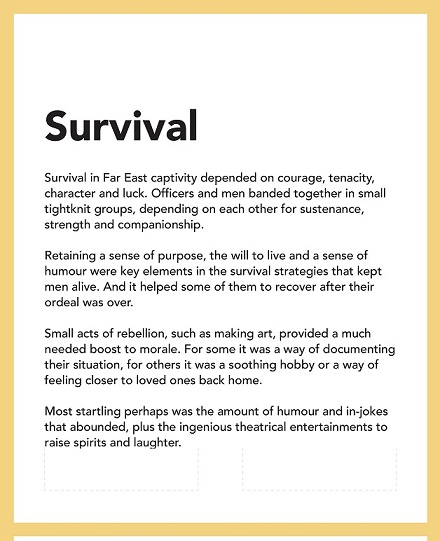
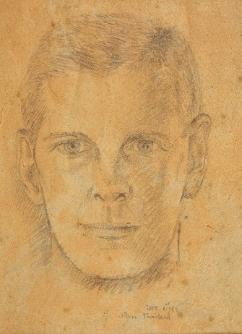
By Gunner William Carthew Wilder, 135 Field Regt., RA
Pencil on paper
Loaned by Anthony Wilder
Fergus Anckorn was charismatic, a born performer. He was a magician, and at the age of 17 was the youngest person to be admitted to the elite Magic Circle of magicians. The Japanese were enthralled by magic and during captivity Fergus used it as a means to gain extra food. When he died in 2018 aged 99, Fergus was the oldest performing member of the Magic Circle.
The portrait was done on a piece of flimsy coloured paper which is now very fragile, though the portrait remains clear despite the paper being torn and damaged.
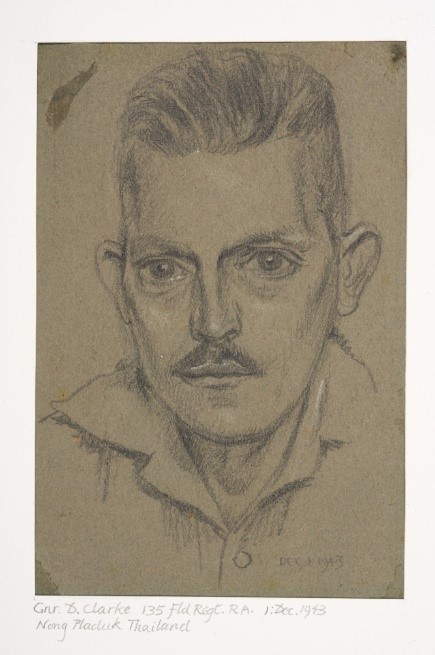
By Gunner William Carthew Wilder, 135 Field Regt., RA
Graphite on paper
Loaned by Anthony Wilder
By the time this portrait was done Clarke had been in Thailand over a year and had been in work camps up country as far north as Kinsaiyok. Clarke’s eyes tell their own story.
Wilder had had formal art training pre-war and was teaching art when he enlisted in August 1940 while Clarke, eight years his senior, was a keen amateur artist. Both men survived captivity and remained friends through the post-war years.
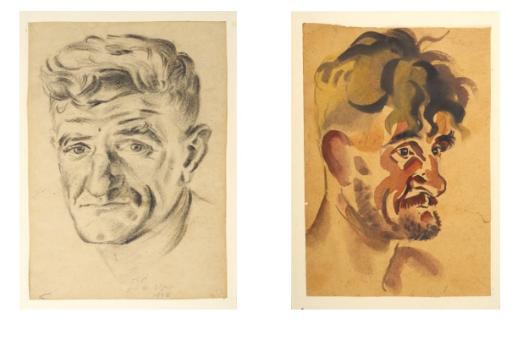
Two Portraits of Charlie Proctor, Changi 1942 & Thailand late 1943
By Gunner Ashley George Old, 1/5 Sherwood Foresters Regt.
Pencil on paper
Watercolour on paper
Loaned by the Bartholomew Family
These two portraits are of the same man, Private Ernest Charles Proctor, the oldest member of the 1/5 Sherwood Foresters Regt in captivity in the Far East. They were both done by the same artist during captivity and 18 months apart. Created by Gunner Ashley George Old of the same regiment as Charlie, the pencil sketch on the right was done in early 1942 during the first weeks of captivity at Changi POW camp in Singapore. By late 1943 both men were at Chungkai Hospital camp in Thailand when the second, watercolour, portrait was done. The difference between the two portraits is stark. Both men survived captivity.
Old said he painted over a thousand such portraits during captivity. LSTM knows of the whereabouts of 17 and hopes to find more, visit www.captivememories.org.uk for more information.
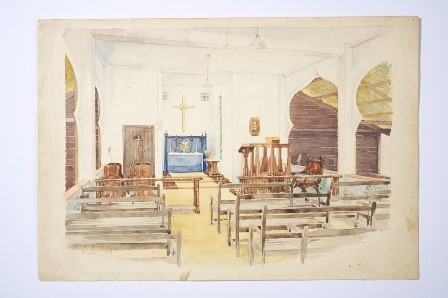
By Lt. Eric Francis Stacy, 560 Field Coy, RE
Watercolour & pencil on paper
Loaned by the Cordingly Family
Over time the former mosque was refurbished, with coconut matting covering the floor of the nave and fixtures and fittings, including pews, side rails, a pulpit and the large wooden cross above the altar made in nearby workshops by POW carpenters and craftsmen. Floodlights, made from car headlamps, shone in the evenings on the large wooden altar cross. A smaller brass cross was later fashioned out of a 4.5 howitzer shell case and placed on the altar. This was finely engraved and highly polished.
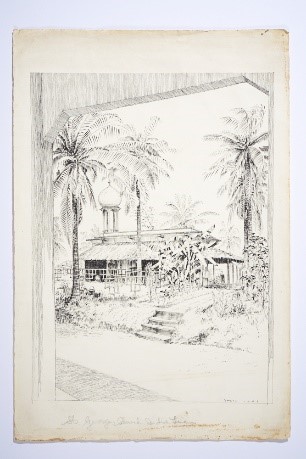
By Lt. Eric Francis Stacy, 560 Field Coy, RE
Ink on paper
Loaned by the Cordingly Family
This is a particularly pleasing view of St George’s, set in a shady area with palm trees and flowering shrubs all around. It has wide and low attap-roofed verandas on three sides and minaret topped by a cupula, previously used for the call to prayer. It appears to have been drawn from the veranda of an adjacent concrete structure. Stacy helped to design and build several chapels and churches in captivity in Singapore.
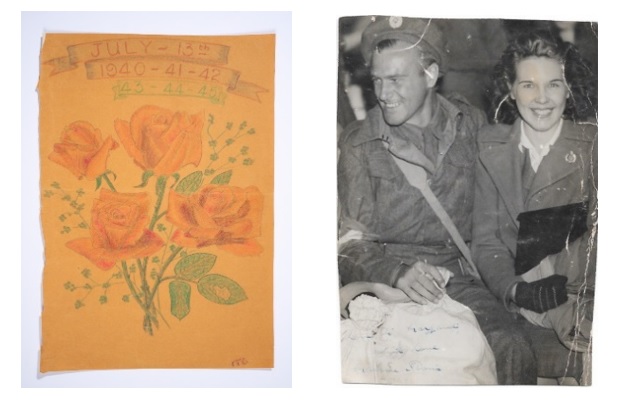
By CQMS Maurice Charles Green, 287 Field Coy, RE
Loaned by the Green Family
Green kept the small card with him throughout his captivity in camps in Singapore and Thailand, marking off the years as each 13th July anniversary passed. This is a simple and yet poignant reminder of a young soldier’s longing to return to hearth and home. Green had joined the army as a boy soldier, aged 15 in 1931. He returned to his unit after extended leave, in 1946.
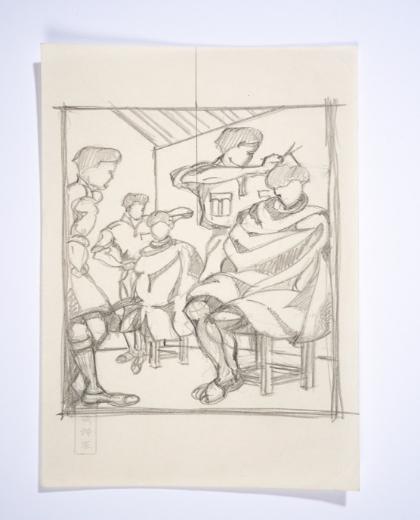
By Capt. Godfrey Vernon Bird, RE
Pencil on paper
Loaned by Derek Bird
The sketch was drawn by Captain Bird, a trained architect who had worked in the colony for several years. He used his considerable artistic talent to create dozens of sketches during captivity. As well as documenting camp life he also produced from memory dozens of illustrations depicting myriad building styles and detail, which he used as teaching notes for talks and lectures he gave on the history of architecture.
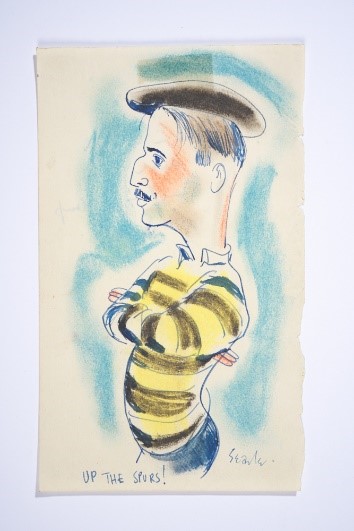
By Sapper Ronald William Fordham Searle, 287 Field Coy, RE
Pastel & ink on paper
Loaned by the Horner Family
Searle, a trained artist, documented life and death in captivity in his distinctive spiky style. He was lucky to survive several serious bouts of illness both in Singapore and in Thailand. In his memoir he described waking up one morning to find a snake coiled under his head, with two friends lying either side of him, both dead.
A fellow prisoner later recalled of Searle: “If you can imagine something that weighs six stone or so, on the point of death… calmly lying there with a pencil and a scrap of paper, drawing, you have some idea of the difference of temperament that this man had from the ordinary human being.”
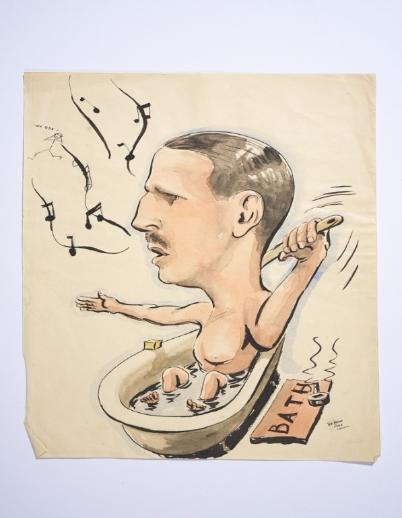
By L/Bombardier Desmond Bettany, 88 Field Regt., RA
Watercolour and ink on paper
Loaned by the Horner Family
He documented all aspects of life, from the serious to the hilarious, using watercolour, pen and ink, pastels and pigments derived from local clays. The latter provided a rich array of colours including white, brown, ochre and red. Dried and then ground using bottles, the pigments were mixed with rice water to help adherence. They have lasted the test of time. Bettany’s artwork is also displayed digitally in the exhibition.
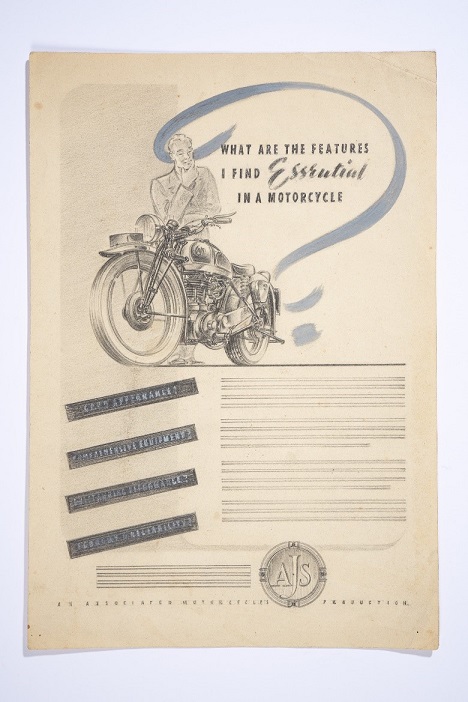
By Corporal William George ‘Bill’ Norways, 2Btn Cambs Regt., RA
Pencil gouache
Loaned by Graeme and Toby Norways
Norways studied at the Chelsea School of Art graduating in 1936 and then worked as a commercial artist before the war. During captivity in Changi POW camp he lectured on Advertising and Art as part of the ‘Changi University’. He was heavily involved in theatricals in camps in Singapore and Thailand and painted detailed studies of medical facilities at Kranji POW Hospital camp after his return to Singapore in late 1943.

By Sapper Geoffrey Barlow Gee, 560 Field Coy, RE
Colour pencil
Photograph print
Loaned by Jill Fleming, daughter of Vera and Edward John Mayne
Gee’s distinctive signature is clearly seen bottom right: the vertical lines extending down from each stylised “G” in his name appear to resemble posts, criss-crossed by two intersecting lines of barbed wire.
Gee, from Scotland, was involved with theatricals, painting sets, posters and programmes for productions like, Night Must Fall, which opened on 23 June 1944 at Chungkai Hospital camp in Thailand. In a letter to Professor Sears Eldredge, Gee commented: “The whole thing was first class from every angle… its wonderful what we prisoners-of-war can do!”
NB Professor Sears Eldredge: Captive Audiences/Captive Performers

By Capt. Thomas ‘Toss’ Wilson, RAMC
Ink wash on paper
Loaned by the Wilson Family
Artists created professional billboard posters and programmes as well as magical scenery and stage sets. A host of volunteers made wigs, costumes and applied makeup. In camps in Singapore, Thailand, Hong Kong, Tandjong Priok and Bandoeng (in Java), professional actors, musicians, producers and directors planned, wrote and put on highly-accomplished shows. The performers did their best to entertain and distract, raising morale and transporting both audiences and themselves to another time, another place.
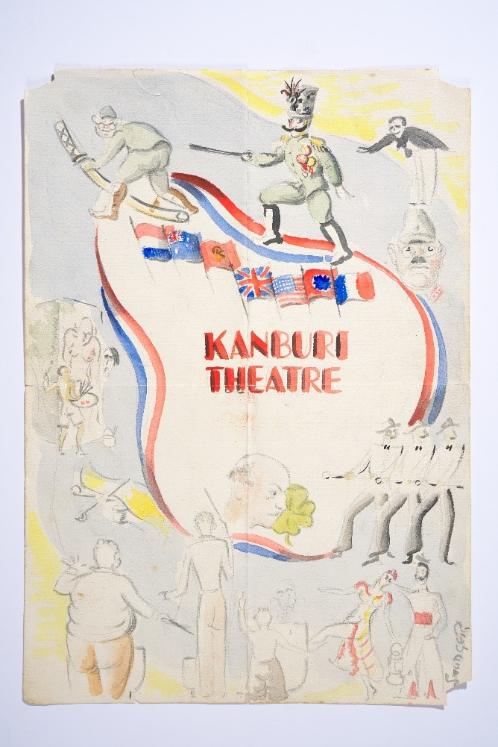
By Lt Fred William H. Ransome-Smith, 5 Suffolks Regt., RA
Watercolour & pencil on paper
Loaned by Neil Pearson
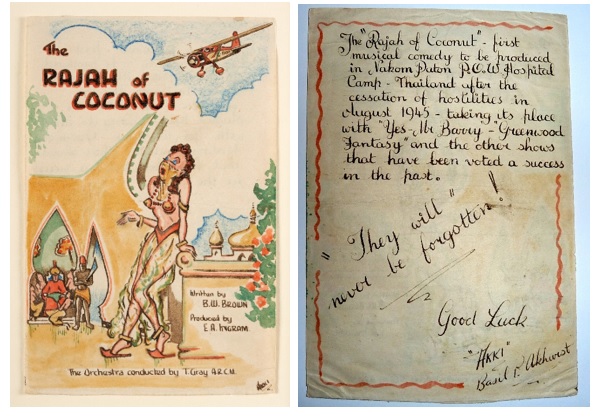
By Bombardier Basil Parry ‘AKKI’ Akhurst, 137 Field Regt., RA
Watercolour and pencil on paper
Loaned by Richard Brown, son of play’s author, Bernard Brown, 2nd Battalion East Surrey Regt.
Jack Chalker describes the show in great detail and hilarity in his memoir, Burma Railway Artist. It featured an elephant, the costume made from a framework of bamboo strips shaped to form the large body, covered with plaited bamboo panels and finished off with grey woodash smeared over the body. Needing two men inside the elephant, it caused much hilarity. However, it all nearly ended in tragedy when, part way through one scene the animal collapsed on stage amid howls of mirth from the audience. Chalker relates that both men had to be dragged out semi-conscious, having been asphixiated by the ash!
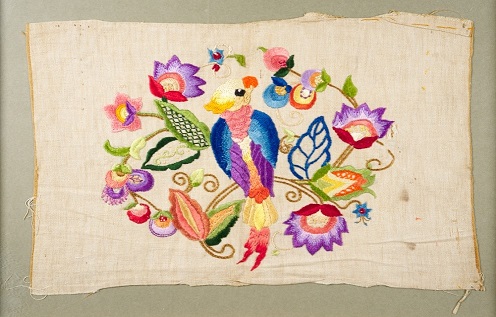
By Gunner Jack Bridger Chalker, 118 Field Regt., RA
Fabric
Loaned by Guy Chalker-Howells
He came across the silks and cloth during the fighting in Singapore in early 1942. Chalker was sent to an outlying observation post and had to make his way through bomb-damaged houses. In one, amid the dust and chaos of the hallway, he noticed bright colours lying in the debris. The contents of a sewing chest had been blown apart. Snatching up a handful of coloured Chinese silks he wrapped them in a piece of cloth and stuffed them in his haversack.
It was nearly two years later in Thailand that a sick Australian POW “with huge hands…” lying next to Chalker, showed him the rudiments of embroidery stitching.